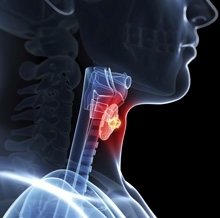What patients need to know
The incidence of thyroid cancer has been steadily rising for the past decade. Thyroid nodules, which can harbor cancer, are very common, affecting half of women by age 50 and 30% of the population overall. While most thyroid nodules are non-cancerous, between 5 and 15% are malignant, making it important for everyone to have thyroid nodules properly evaluated. Doctors are now able to diagnose thyroid cancer at much earlier stages than they could in the past, because ultrasound technology enables the detection of small thyroid nodules that could not be easily detected before.
According to Jennifer H. Kuo, MD, who directs the multidisciplinary Thyroid Biopsy Clinic at NewYork-Presbyterian/Columbia Department of Surgery, fine needle aspiration biopsy (FNA) evaluation can reliably determine whether a nodule is benign or cancerous about 65-82% of the time. But in about 22% of patients, test results are indeterminate, meaning that based on FNA testing, doctors can not say for sure whether a nodule is cancerous or not. Approximately 15-30% of nodules with indeterminate results actually have cancer, and due to this risk, many patients undergo diagnostic surgery (diagnostic thyroid lobectomy). After surgery, most patients are relieved to learn they do not have cancer—but they have been unnecessarily subjected to the risks and costs of surgery, albeit low, and a quarter of these patients progress to needing life-long thyroid hormone replacement as a result of their surgery.

To help avoid performing unnecessary procedures, experts have sought to improve the detection of cancer in thyroid nodules through the development of new molecular based tests. Experts are hopeful that molecular testing can detect specific gene mutations that play a role in thyroid cancer or may help to reveal whether thyroid cancer is present within a thyroid nodule. This diagnostic avenue is gaining momentum, and many patients now come to the Thyroid Center requesting molecular testing for thyroid nodules. However, according to Dr. Kuo, it is important that patients understand the limitations of these tests.
At this time, two approaches for molecular testing for thyroid cancer are currently available. The first type tests for specific DNA mutations, and the most commonly used version detects seven genetic mutations known to be involved in thyroid cancer. The second approach, called a gene classifier, uses RNA to look at differential gene expression rather than specific mutations. The DNA approach has a sensitivity of 60% and specificity of 98%, while the gene classifier test has a sensitivity of 92% and specificity of 52%.
Sensitivity, also called the true positive rate, refers to the number of patients who actually have the disease within the group of patients who test positive for the disease. The high sensitivity of the gene classifier test means it can detect 92% of cancers in thyroid nodules with indeterminate cytology, but there is a false negative rate of 8-15%, meaning that the test can miss 8-15% of cancers that are present in thyroid nodules. In addition, the test has an overall high false positive rate of 53%, meaning that it identifies many people at risk of thyroid cancer, but who do not actually have the disease. This limits the test’s ability to help guide appropriate management of the disease.
Specificity, also called true negative, measures the proportion of negative test results that are correctly identified–in this case, the proportion of patients who do not show markers of thyroid cancer. A test with a high specificity rate may help to guide surgical management of thyroid cancer, but is not a good test to rule out the presence of cancer. Ideally a test would have 100% sensitivity and 100% specificity, but both tests clearly fall short of that mark.
What do these limits mean for the usefulness of molecular testing? Is it at all helpful in guiding treatment plans? Given the high rate of false positives with one test and false negatives with the other, the Thyroid Biopsy Clinic uses them with caution. “The predictive value of the current tests is not as useful as we would like them to be,” says Dr. Kuo. “We know the gene classifier test misses cancers, but for patients at high risk of surgery, it can give a little more clinical information with which to make good judgment.” Instead of relying on either test as a foolproof indicator, she and her colleagues at the Thyroid Center consider them along with many other factors when forming their patients’ treatment plans.
In addition to the limitations in accuracy of the tests, another problem with the gene classifier test is that it must be sent away for processing, which can take up to a month in some cases. Given the anxiety that patients experience while waiting for test results, along with the limitations in accuracy described above, Dr. Kuo and colleagues have decided to develop a better test that can be processed right at NYP/Columbia. They have formed a 10-member multidisciplinary team including specialists in endocrine surgery, medical endocrinology, molecular cytology, and surgical pathology. At this time, the team is working to optimize their technique and determine the design of their molecular panel. When the test is ready, it will be validated in a clinical study before becoming widely available.
A better molecular test is unlikely to improve mortality rates from thyroid cancer, since thyroid cancer so rarely causes death, explains Dr. Kuo. However a molecular test with strong predictive capability could potentially save a significant number of patients from undergoing thyroid surgery and needing thyroid replacement hormone. “This is a very promising tool in the evaluation of thyroid nodules, but it is currently a work in progress and still an evolving field,” she says.
